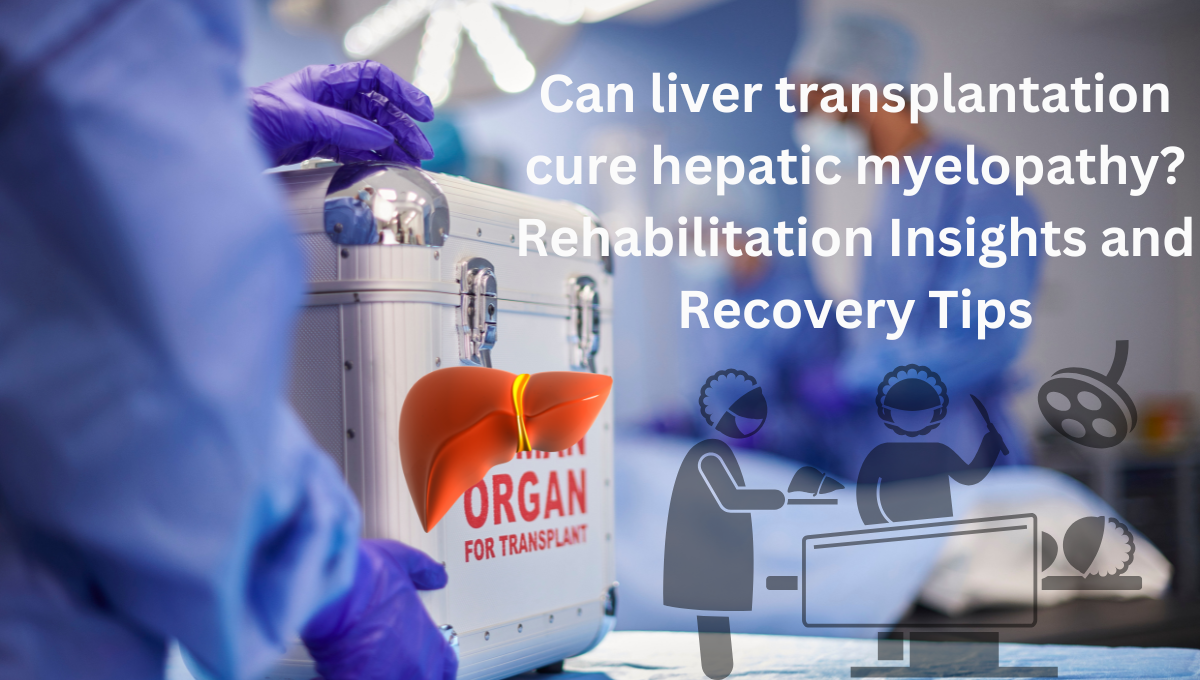Can liver transplantation cure hepatic myelopathy? Rehabilitation Insights and Recovery Tips
Overview
People with advanced liver illness may develop hepatic myelopathy, an uncommon but serious neurological disorder that frequently coexists with cirrhosis or portal hypertension. The spinal cord is the primary organ affected by the illness, which causes gradual muscle weakness, particularly in the legs, and makes walking difficult. Although hepatic myelopathy (HM) cannot be cured, liver transplantation has shown promise as a therapy option, and thorough rehabilitation is essential for enhancing mobility and general quality of life.
This article will discuss the connection between hepatic myelopathy and liver illness, the function of liver transplantation, and the significance of an organized rehabilitation program in controlling or reversing HM symptoms.
Knowledge of Hepatic Myelopathy
A rare neurological condition linked to chronic liver disease is hepatic myelopathy. It mostly impacts the spinal cord, causing symptoms like
Progressive leg weakness: Individuals may experience progressively worsening leg weakness, which will ultimately impair their gait.
Spasticity: Movement is difficult due to the common involuntary leg spasms and stiffness.
Balance and coordination issues: Patients frequently struggle to regulate their leg motions or keep their balance.

How Hepatic Myelopathy Is Caused by Liver Disease
People with severe liver illness, especially those who have had portal hypertension for a long time, develop hepatic myelopathy. Although the precise origin is unknown, scientists think that the buildup of toxins in the blood could be the reason. Over time, neurological damage can result from dangerous compounds like ammonia entering the central nervous system due to the liver’s ineffective detoxification of the blood.
Liver myelopathy does not occur in all patients with severe liver disease. Long-term liver dysfunction, a history of portal hypertension, and insufficient control of the body’s toxins are some risk factors that may raise the probability.
Hepatic Myelopathy Treatment Options: Liver Transplantation
The only proven cure for hepatic myelopathy that can sometimes stop or reverse disease is liver transplantation. Liver transplantation restores the body’s capacity to cleanse blood by substituting a healthy liver for the sick one, which may lessen or even reverse neurological damage.
How Liver Function Is Restored by Liver Transplantation: Toxins like ammonia can be processed and filtered out by the new liver, avoiding their buildup in the circulation.
Stopping Neurological Decline: Liver transplantation has been demonstrated to occasionally stop the advancement of hepatic myelopathy and may even result in a partial or complete reversal of symptoms.
Enhancing General Health: The body generally gets healthier because the new liver can perform all necessary liver functions, which enables patients to participate more effectively in supporting therapies and rehabilitation.
But for some people, liver transplantation is not a quick fix. A patient’s suitability as a candidate depends on a number of factors, including the presence of a compatible liver, the patient’s general health, and the stage of liver disease. Furthermore, liver transplantation is not a solution for all cases of hepatic myelopathy, even though it may alleviate symptoms. Depending on personal characteristics, recovery and symptom improvement can differ.
Complete Recovery Following Liver Transplantation
Even though liver transplantation may be able to correct hepatic myelopathy, patients may still have postoperative muscle stiffness, residual weakness, or decreased movement. At this point, thorough rehabilitation becomes crucial. Patients’ strength, mobility, and quality of life can all be improved with the support of a well-organized, interdisciplinary rehabilitation program.
Essential Elements of an All-Inclusive Rehab Program: Physical Therapy
Regaining muscle strength, flexibility, and coordination is the main goal of physical therapy. In order to restore leg strength, enhance balance, and lessen stiffness, therapists collaborate with patients to create exercises that are specific to their skills.

Strength training: Leg muscle exercises aid in regaining strength, which is necessary for walking and preserving one’s independence.
workouts for Balance and Coordination: By increasing stability, these workouts make everyday tasks like walking safer and simpler.
Flexibility and Stretching Work: By reducing muscle rigidity and spasticity, stretching exercises facilitate more fluid movement.
The field of occupational therapy
Patients who struggle with everyday skills and activities because of physical limitations can benefit from occupational therapy. Practicing basic skills like grooming, clothing, and other activities of daily living (ADLs) may fall under this category.

Adaptation Strategies: To help patients with limited mobility with everyday duties, therapists can suggest adaptable instruments or techniques.
Home Modifications: To lower the chance of falls or other mishaps, occupational therapists can recommend changes to make the house safer.
Training for Gait
The specific goal of gait training is to assist patients in improving their walking patterns or relearning how to walk. It’s an organized method that might use support equipment like walkers, parallel bars, or harnesses.
Assisted Walking: Patients can walk more securely and confidently by using equipment like crutches or walkers.
Enhancing Walking Mechanisms: By addressing anomalies in gait, therapists can help patients walk more comfortably and naturally.
Rehabilitation of the Nervous System
Neurological therapy can assist patients to regain motor abilities, enhance coordination, and manage spasticity because hepatic myelopathy impacts the nervous system.
Functional Electrical Stimulation (FES): FES helps increase muscular tone and control by stimulating weak muscles.
Management of Spasticity: Methods such as splinting, stretching, and occasionally medicine can be used to control muscle rigidity and spasms.
Support for the Mind
It can be difficult to cope psychologically with hepatic myelopathy, liver transplantation, and rehabilitation. Counseling and support groups are examples of psychological support that can assist patients and their families in overcoming emotional obstacles.
Counseling: Patients and their loved ones can deal with stress, anxiety, or depression with the support of individual or family counseling.
Support groups: Making connections with people going through comparable struggles offers inspiration, support, and a feeling of belonging.
Support for Nutrition
Recovery is greatly aided by proper nutrition, particularly following major surgery such as a liver transplant. Patients can acquire the nutrition they require to promote muscle function, healing, and general energy levels with the assistance of a dietician.

A balanced diet can promote energy levels and muscle regeneration by consuming a range of foods, such as complex carbs, proteins, and healthy fats.
Managing Fluid and Electrolytes: Patients with liver disease and those recuperating from transplantation require careful control of their fluid and electrolyte levels.
Possible Obstacles in Rehabilitation
Hepatic myelopathy and liver transplant recovery can be drawn out and difficult, with the following possible roadblocks:
weariness and Low Energy: Following a transplant, patients frequently experience severe weariness, which may limit their capacity to participate completely in rehabilitation.
Risk of Infection: Immunosuppressive drugs taken by transplant recipients may raise the risk of infection and occasionally restrict specific rehabilitation exercises.

Psychological Stress: Managing a chronic illness, surgery, and recuperation can have a profound emotional impact, making robust support systems necessary.
Limited Progress in Certain Patients: Liver transplantation can halt the progression of hepatic myelopathy, but some patients may still have unreversible residual symptoms.
Patients can overcome these obstacles and make consistent progress with a lot of aid from patience, perseverance, and an optimistic attitude.
Conclusion: The Path to Recuperation
Patients with hepatic myelopathy, a disorder that can seriously lower quality of life, have hope through liver transplantation and thorough rehabilitation. While rehabilitation aims to restore strength, movement, and independence, liver transplantation deals with the underlying cause of the body’s accumulation of toxins.
Every patient’s journey is different, with varying difficulties and results. Patients can attain the best outcomes with a mix of medical intervention and a dedicated rehabilitation program, which not only prolongs life but also improves quality of life.
Liver transplantation and rehabilitation combined offer the potential for better health, mobility, and well-being for people with hepatic myelopathy and liver disease.

